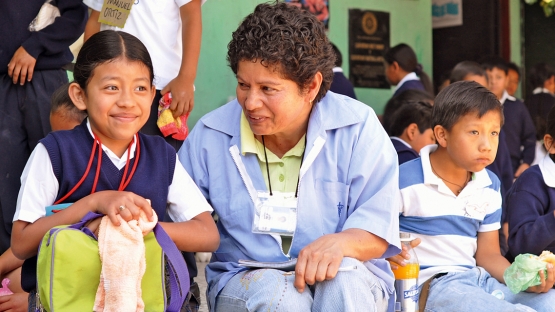With the help of nuclear techniques, scientists and health workers in Guatemala are now able to identify the causes and consequences of malnutrition in the country's children, enabling policymakers to devise strategies to combat obesity and stunting.
The country has one of the highest rates of chronic malnutrition in the world, and tackling it is a key priority for the government, said former Social Development Minister Lucy Lainfiesta.
"The Guatemalan Government's proposal for fighting chronic malnutrition will emphasize the window of opportunity found in the first 1000 days of life, through interventions that will ensure that mother and child have what they need to be well nourished," she said.
Projects using isotope technology to assess nutritional status are "beginning to make a positive and noticeable impact in our nutrition programmes," said Manuel Ramirez, Coordinator of the Research Centre for the Prevention of Chronic Diseases, from the Institute of Nutrition of Central America and Panama (INCAP). "Nuclear science and technology gave us the tools to understand and associate body composition with physiological changes that can lead to disease later in life."
Measuring children's total body water using isotopic tracers helps to determine their body composition, and the percentage of fat in their body, which in turn allows specialists to prescribe the right diet (see Using isotopes to measure body composition).

(Source: jawon.com)
The IAEA's support has helped Guatemala and other Member States to have the necessary information and data to design or improve their nutrition programmes. These include increasing the intake of vitamins and minerals through food fortification or micronutrient supplementation, complementing advocacy for healthy eating, and increased physical activity.
Fewer tortillas, more carrots
Lack of protein and micronutrients in diets, composed mainly of high carbohydrate foods, is a major reason for malnutrition in Guatemala, according to Ramirez. Health workers have noticed that in rural areas, children between six months and three years of age regularly eat corn tortilla softened with caffeinated drinks. This food is not beneficial for infants and young children, who should instead eat healthier locally produced food like eggs, avocado, bananas, soft cooked vegetables, beans, rice and oatmeal. Poor quality diets in infancy can lead to obesity later in life. With the help of nuclear techniques, scientists are able to track the amount of protein absorbed by the body and make diet recommendations accordingly, keeping in mind the availability of ingredients locally, explained Christine Slater, Acting Head of the Nutrition Section at the IAEA.
While obesity is the main health challenge among children in the cities, in rural areas, the indigenous population mostly suffers from the opposite problem. Nearly eight out of ten indigenous children are stunted, compared to just four out of ten non-indigenous children, Ramirez said. The latest research results have clarified that, contrary to popular belief, the short stature of indigenous Guatemalans is not due to genetics. It is caused by inappropriate feeding practices and poor diet in the early years of life, he said.
Stunting is a major contributor to poverty, Ramirez said. Stunted children face learning difficulties, which prevents them from earning well later on in life. There is an urgent need to ensure that diverse nutritious diets are available and accessible.
While all stunted children need adjustments to their diets, nuclear techniques can help determine how their diets should be changed, Slater said. "There is a growing realization that measuring the weight and height of children is not enough," Slater explained. "We need to understand body composition in order to determine healthy growth."

Evaluating food acceptability of healthy recipes for school age children.
(Photo: INCAP/CIIPEC)
Children who are obese, stunted or both tend to lead less healthy lifestyles and suffer more health problems later in life, Ramirez said. "These children walk less, have lower oxygen consumption and poor blood circulation," he said.
With the information and data collected under IAEA projects, a task force endorsed by eight health ministers from Central America was established in June 2014 to develop a regional policy on the prevention and management of obesity in children and adolescences.
Nuclear science and technology gave us the tools to understand and associate body composition with physiological changes, which can help to prevent disease later in life.





